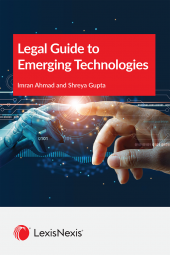Legal Guide to Emerging Technologies
One Year Subscription Only Terms
Subscribers receive the product(s) listed on the Order Form and any Updates made available during the annual subscription period. Shipping and handling fees are not included in the annual price.
Subscribers are advised of the number of Updates that were made to the particular publication the prior year. The number of Updates may vary due to developments in the law and other publishing issues, but subscribers may use this as a rough estimate of future shipments. Subscribers may call Customer Support at 800-833-9844 for additional information.
Subscribers may cancel this subscription by: calling Customer Support at 800-833-9844; emailing customer.support@lexisnexis.com; or returning the invoice marked 'CANCEL'.
If subscribers cancel within 30 days after the product is ordered or received and return the product at their expense, then they will receive a full credit of the price for the annual subscription.
If subscribers cancel between 31 and 60 days after the invoice date and return the product at their expense, then they will receive a 5/6th credit of the price for the annual subscription. No credit will be given for cancellations more than 60 days after the invoice date. To receive any credit, subscriber must return all product(s) shipped during the year at their expense within the applicable cancellation period listed above.
Product description
Technological progress has never been more rapid, complex or innovative. Legal counsel and business leaders face the ever-growing challenge of not only staying up to date with the latest technological developments, but also navigating the legal implications associated with their adoption. Understanding and navigating emerging technologies is now important for all businesses – even if an organization is not developing technology, it is certainly procuring or otherwise relying on it.
Legal Guide to Emerging Technologies serves as a one-stop shop for legal counsel and business leaders as they navigate the growing involvement of emerging technologies. It provides an overview of six emerging technologies that are poised to drive many changes in the upcoming years:
- Biometric Data
- Autonomous Vehicles
- The Internet of Things
- Generative Artificial Intelligence
- The Metaverse
- Blockchain and Non-Fungible Tokens (NFTs)
Legal Guide to Emerging Technologies covers the various legal implications associated with these six emerging technologies, outlines the legal framework in Canada as well as in select foreign jurisdictions, and provides best practices for legal counsel when dealing with these new technologies.
Who Should Read This Book
- Legal advisors, such as privacy and access lawyers, technology lawyers, in-house counsel, public sector counsel and legal researchers who need assistance with researching and advising on these emerging technologies
- Regulators, law enforcement personnel and policy makers, including judicial personnel and judges who require a summary of the evolving area of these emerging technologies
- Corporations and business professionals, such as risk and compliance managers, technology consultants, corporate investigators and privacy officers who need guidance on complying with these emerging technologies
- Professors, law students and law libraries who require a teaching aid or reference work covering these emerging technologies
Table of contents
CHAPTER 1: BIOMETRIC DATA
INTRODUCTION
LEGAL CONSIDERATIONS
CURRENT LEGAL FRAMEWORK
BEST PRACTICES
CHAPTER 2: AUTONOMOUS VEHICLES
INTRODUCTION
LEGAL CONSIDERATIONS
CURRENT LEGAL FRAMEWORK
BEST PRACTICES
CHAPTER 3: THE INTERNET OF THINGS
INTRODUCTION
LEGAL CONSIDERATIONS
CURRENT LEGAL FRAMEWORK
BEST PRACTICES
ADDITIONAL RESOURCES
CHAPTER 4: GENERATIVE ARTIFICIAL INTELLIGENCE
INTRODUCTION
LEGAL CONSIDERATIONS
CURRENT LEGAL FRAMEWORK
BEST PRACTICES
CHAPTER 5: THE METAVERSE
INTRODUCTION
LEGAL CONSIDERATIONS
CURRENT LEGAL FRAMEWORK
BEST PRACTICES
CHAPTER 6: BLOCKCHAIN AND NON-FUNGIBLE TOKENS
INTRODUCTION
LEGAL CONSIDERATIONS
CURRENT LEGAL FRAMEWORK
BEST PRACTICES
INDEX
 Lexis Nexis
Lexis Nexis 


